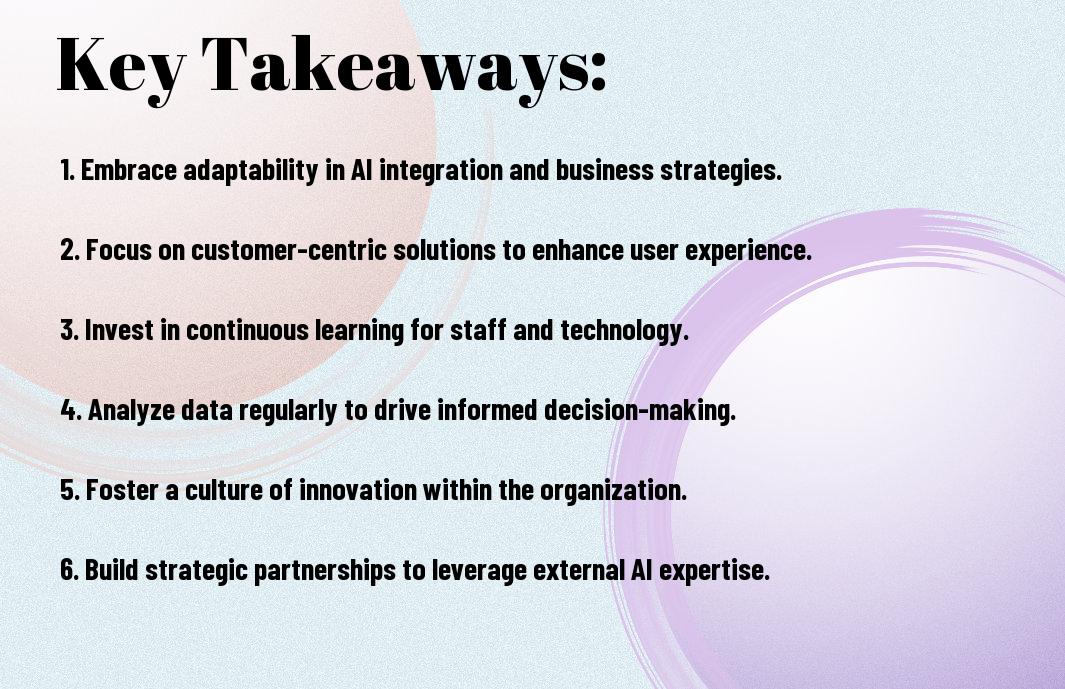As you launch on building a successful business, you’re likely considering how to leverage artificial intelligence to drive growth and stay competitive. Your goal is to create a company that not only thrives today, but also endures for years to come. You understand that incorporating AI into your business strategy can be a game-changer, and you’re eager to learn how to harness its power to drive innovation, efficiency, and profitability, setting your business up for long-term success.
Key Takeaways:
- Develop a clear understanding of your business goals and identify areas where AI can be leveraged to drive growth, improve efficiency, and enhance customer experience, ultimately building a strong foundation for long-term success.
- Invest in data quality and management, as high-quality data is imperative for training and deploying effective AI models that can provide actionable insights and inform business decisions.
- Foster a culture of innovation and experimentation, encouraging collaboration between human and machine to unlock new opportunities and stay ahead of the competition in an ever-evolving business landscape.
- Implement AI solutions that are transparent, explainable, and accountable, ensuring that your business can maintain trust with customers, stakeholders, and regulatory bodies, and adapt to changing market conditions.
- Continuously monitor and evaluate the impact of AI on your business, making adjustments as needed to ensure that AI-enhanced systems remain aligned with your overall business strategy and continue to drive value over time.
Foundations of AI-Enhanced Business Models
To build a successful AI-enhanced business, you need to understand the fundamentals of AI-driven models. You will learn how to leverage AI to drive growth, improve efficiency, and enhance customer experiences, setting your business up for long-term success.
Identifying Core Business Processes for AI Integration
By analyzing your operations, you can identify areas where AI can have the most impact, streamlining processes and improving productivity, allowing you to make informed decisions about where to apply AI solutions.
Balancing Innovation with Proven Business Principles
Any successful AI-enhanced business must strike a balance between innovation and established practices, ensuring that new technologies serve your overall strategy, and you can achieve this by prioritizing your goals and evaluating AI solutions based on their potential impact.
Principles such as customer-centricity, financial discipline, and operational efficiency are vital to your business’s longevity, and when you integrate AI, you should consider how these principles can be augmented and supported by new technologies, rather than replaced, allowing you to innovate while maintaining a solid foundation for your business.

Strategic Implementation of AI Technologies
While implementing AI technologies, you need to consider your business goals and objectives. You should assess your current infrastructure and identify areas where AI can bring the most value. This will help you make informed decisions about which AI solutions to adopt and how to integrate them into your business.
Selecting the Right AI Solutions for Your Industry
By evaluating your industry’s specific needs, you can choose AI solutions that address your unique challenges. You should consider factors such as data availability, scalability, and compatibility with your existing systems. This will enable you to select the most effective AI solutions for your business.
Creating a Scalable AI Infrastructure
Solutions such as cloud-based services and flexible architectures can help you build a scalable AI infrastructure. You should design your infrastructure to accommodate growing amounts of data and increasing computational demands. This will allow you to expand your AI capabilities as your business grows.
Strategic planning is important when creating a scalable AI infrastructure. You should consider your long-term goals and develop a roadmap for AI adoption. This will help you prioritize investments, allocate resources effectively, and ensure that your AI infrastructure supports your business objectives. As you build your AI infrastructure, you should also consider factors such as data management, security, and maintenance to ensure that your systems remain efficient and effective over time.

Human-AI Collaboration Framework
Despite the potential of AI, you need a framework to collaborate effectively with your human workforce. This framework will help you leverage AI’s capabilities while ensuring your business remains agile and adaptable in a rapidly changing environment.
Developing AI-Ready Workforce Capabilities
Among the key factors in building a successful human-AI collaboration is developing your workforce’s capabilities to work with AI. You will need to invest in training and upskilling your employees to ensure they can effectively utilize AI tools and technologies.
Establishing Ethical Guidelines for AI Use
Against the backdrop of increasing AI adoption, you must establish ethical guidelines for its use in your business. You will need to consider issues like data privacy, bias, and transparency to ensure your AI systems are fair and trustworthy.
Indeed, establishing ethical guidelines for AI use is necessary to maintaining your business’s reputation and building trust with your customers. You should consider developing a comprehensive ethics framework that outlines the principles and values that will guide your AI development and deployment, and ensure that your AI systems are aligned with your business’s overall mission and values. This will help you navigate the complex ethical landscape of AI and ensure that your business remains responsible and accountable.
Data Architecture for Longevity
Many businesses struggle to create a data architecture that supports long-term growth. You need to design a system that can adapt to changing needs and technologies, ensuring your business remains competitive.
Building Robust Data Collection Systems
Around the clock, your systems should be collecting and processing data to inform your business decisions. You should focus on building robust data collection systems that can handle large volumes of data and provide accurate insights.
Implementing Adaptive Analytics Frameworks
Any successful business needs to be able to analyze and act on data quickly. You should implement adaptive analytics frameworks that can help you respond to changing market conditions and customer needs.
Hence, when implementing adaptive analytics frameworks, you will be able to identify trends and patterns in your data, and make informed decisions to drive your business forward. You will be able to create a data-driven culture that enables your business to innovate and stay ahead of the competition, and your adaptive analytics frameworks will be a key component of your overall data architecture, supporting your business’s long-term success.
Navigating Regulatory Landscapes
Unlike other business ventures, building an AI-enhanced business requires careful consideration of regulatory landscapes. As you explore AI opportunities, you can find inspiration in 25+ Profitable AI Business Ideas to ensure your venture stays ahead of the curve.
Compliance Strategies for Evolving AI Regulations
Alike other regulatory environments, compliance strategies for AI regulations involve understanding the evolving landscape and adapting your business accordingly, which enables you to make informed decisions about your AI-enhanced business.
Privacy-Centric Approaches to AI Development
For instance, prioritizing privacy in your AI development process helps you build trust with your customers and maintain a competitive edge in the market, allowing you to create AI solutions that respect user data and privacy.
Development of privacy-centric AI approaches requires you to consider the ethical implications of your AI systems and implement measures to protect user data, which in turn enables you to create AI solutions that not only drive business growth but also respect user privacy, ultimately helping you build a sustainable and trustworthy AI-enhanced business that stands the test of time.
Measuring AI-Driven Business Impact
After implementing AI initiatives, you need to assess their impact on your business. To achieve this, you can visit Creating a content supply chain that will stand the test of time for guidance on building a sustainable business model.
Key Performance Indicators for AI Initiatives
Against the backdrop of your AI strategy, you will need to establish key performance indicators to measure the success of your initiatives, allowing you to adjust your approach as needed to maximize your returns.
Long-term Value Assessment Methodologies
By adopting a long-term perspective, you can better evaluate the effectiveness of your AI investments, considering factors such as customer satisfaction and revenue growth to determine the overall value of your initiatives.
At this stage, you should consider methodologies such as cost-benefit analysis, return on investment (ROI) calculations, and total cost of ownership (TCO) assessments to evaluate the long-term value of your AI investments, enabling you to make informed decisions about your business strategy and ensure the sustainability of your AI-enhanced business model.
Final Words
Conclusively, you now have the foundation to build an AI-enhanced business that stands the test of time. You have learned how to leverage AI to drive innovation and growth in your organization. By integrating AI into your business strategy, you will be able to stay ahead of the competition and achieve long-term success. Your ability to adapt and evolve with AI will be key to your business’s enduring prosperity.
FAQ
Q: What are the key components of building an AI-enhanced business that stands the test of time?
A: To build an AI-enhanced business that stands the test of time, several key components must be in place. First, a clear understanding of the company’s goals and objectives is necessary to determine how AI can be leveraged to drive business success. This involves identifying areas where AI can automate processes, enhance decision-making, and improve customer experiences. Additionally, a strong data foundation is crucial, as AI algorithms rely on high-quality data to learn and make accurate predictions. A talented team with expertise in AI, data science, and business operations is also vital to develop and implement effective AI strategies. Finally, a culture of continuous learning and innovation must be fostered to ensure the company stays ahead of the curve and adapts to changing market conditions.
Q: How can businesses ensure that their AI systems are transparent, explainable, and fair?
A: Ensuring that AI systems are transparent, explainable, and fair is crucial for building trust with customers, employees, and stakeholders. To achieve this, businesses can implement several strategies. First, they can use techniques such as model interpretability and feature attribution to provide insights into how AI-driven decisions are made. Second, they can establish clear guidelines and regulations for AI development and deployment, ensuring that AI systems are designed and tested to avoid bias and discrimination. Third, they can invest in AI auditing and testing tools to detect and mitigate potential issues. Finally, they can foster a culture of accountability and transparency, encouraging open communication and collaboration between AI developers, business leaders, and stakeholders to ensure that AI systems are aligned with human values and ethical principles.
Q: What role does continuous learning and adaptation play in building an AI-enhanced business that stands the test of time?
A: Continuous learning and adaptation are crucial for building an AI-enhanced business that stands the test of time. As AI technologies and market conditions evolve, businesses must be able to adapt quickly to stay competitive. This involves investing in ongoing education and training for employees, as well as encouraging a culture of experimentation and innovation. Businesses can also leverage AI itself to drive continuous learning, using techniques such as reinforcement learning and transfer learning to improve AI models and adapt to new situations. Additionally, businesses can establish partnerships with academia, research institutions, and other industry leaders to stay at the forefront of AI research and development. By embracing a mindset of continuous learning and adaptation, businesses can ensure that their AI-enhanced strategies remain effective and relevant in the face of changing market conditions and technological advancements.



